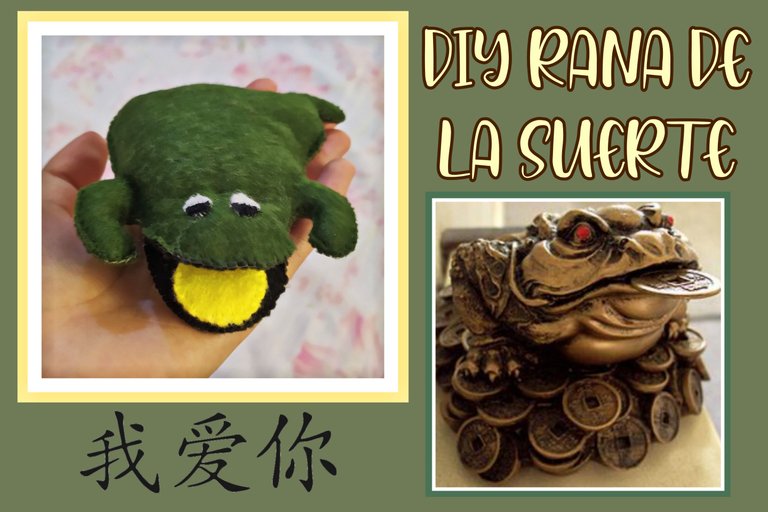

♡Hola amigos de esta linda y creativa comunidad, feliz sábado♡
Hoy les traigo un fácil tutorial para elaborar un amuleto chino de la fortuna.
♡Hello friends of this beautiful and creative community, happy Saturday.♡
Today I bring you an easy tutorial to make a Chinese fortune charm.
Leyendas · Legends
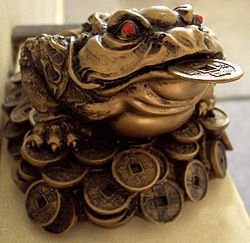
Una vez, un niño campesino estaba jugando en una charca cuando vio una rana y le arrojó una piedra. La rana se escondió bajo el agua. El niño, ya arrepentido, se dirigía todos los días a la charca para darle de comer, pero ésta nunca salía. El niño fue creciendo pero no por ello dejó de dejarle alimentos todos los días. Un día la volvió a ver y notó que tenía tres patas por el golpe que él le había ocasionado años atrás y le pidió perdón. El tiempo pasó y el campesino tuvo un hijo que se enfermó y no tenía dinero para comprar los caros medicamentos que le hacían falta. Un día, cuando el niño estaba agonizando, se escuchó a la rana croar. Ésta entró al lugar donde todos estaban junto al niño con una moneda de oro en la boca, con la que el campesino pudo comprar los medicamentos. La familia del niño, desde entonces, creó la Chan Chu en honor a la rana que los ayudó.
Otra de las leyendas dice que la rana es la esposa de uno de los ocho inmortales, convertida en rana de tres patas como castigo de su avaricia: por eso mismo está siempre con una moneda en la boca. Chan Chu sale todas las noches a recolectar monedas, por lo cual se la puede ubicar cerca de la puerta, mirando hacia dentro o hacia fuera pero siempre en diagonal y nunca directamente enfrentada a la misma (porque en este último caso saldrá de la casa y ya nunca volverá). Deben colocarse en el suelo, dentro o fuera de la casa, pero no en muebles altos pues entonces no podrá saltar y salir de la vivienda para cumplir su misión. También pueden estar en la dirección Sheng Chi de cada uno o en forma más general, al Sudeste.
Créditos a Wikipedia
Once, a peasant boy was playing in a pond when he saw a frog and threw a stone at it. The frog hid under the water. The boy, now repentant, went to the pond every day to feed it, but the frog never came out. The boy grew older but did not stop leaving food for it every day. One day he saw her again and noticed that she had three legs because of the blow he had given her years before, and he asked her forgiveness. Time passed and the farmer had a son who got sick and had no money to buy the expensive medicines he needed. One day, when the child was dying, the frog was heard croaking. It entered the place where everyone was standing next to the child with a gold coin in its mouth, with which the farmer was able to buy the medicine. The boy's family has since created the Chan Chu in honor of the frog that helped them.
Another legend says that the frog is the wife of one of the eight immortals, turned into a three-legged frog as punishment for his greed: that is why he is always with a coin in his mouth. Chan Chu goes out every night to collect coins, which is why she can be placed near the door, facing inwards or outwards but always diagonally and never directly facing it (because in the latter case she will leave the house and never return). They should be placed on the floor, inside or outside the house, but not on high furniture because then it will not be able to jump and leave the house to fulfill its mission. They can also be in the Sheng Chi direction of each one or in a more general way, to the Southeast.
Credits to Wikipedia
Materiales y elaboración · Materials and processing
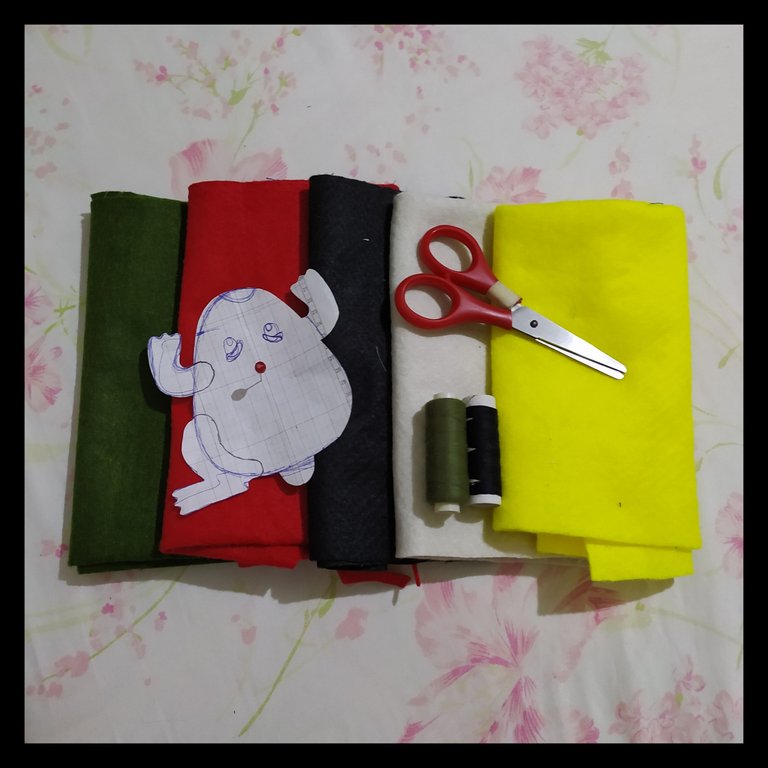
Los materiales que utilicé fueron:
- Fieltro verde, negro, amarillo y blanco
- Hilo y aguja de coser
- Relleno
The materials I used were:
- Green, black, yellow and white felt.
- Sewing thread and needle
- Stuffing
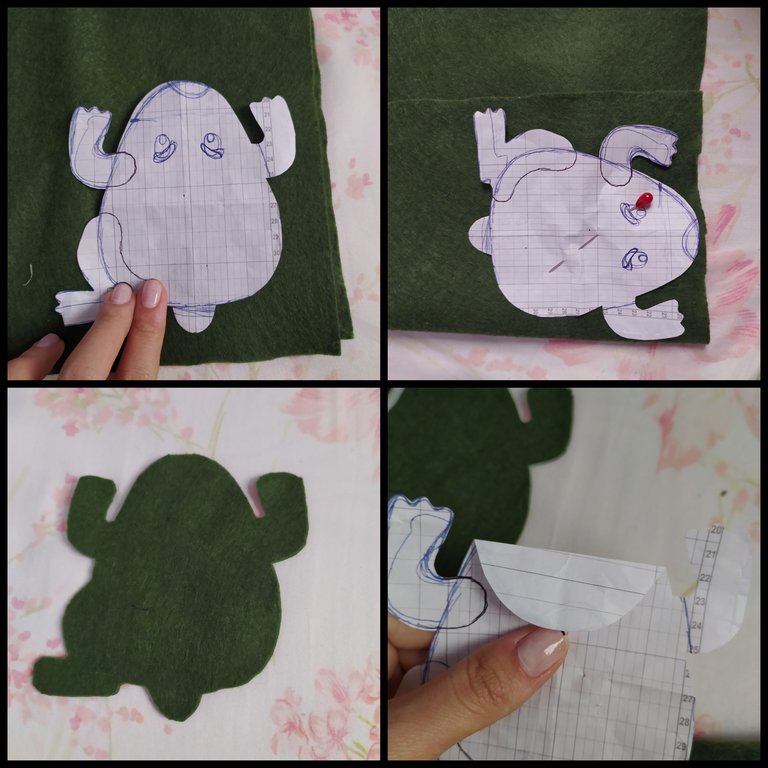
Lo primero que hice fue sacar la forma de mi rana en el fieltro con un patrón que hice previamente.
The first thing I did was to draw the shape of my frog on the felt with a pattern I made previously.

Luego vamos a coser el alredor, dejando un espacio en la boca, de ese espacio sacaremos un ovalo que será la parte interna de la boca de la rana, e irá en color negro.
Then we are going to sew around it, leaving a space in the mouth, from this space we will make an oval that will be the internal part of the frog's mouth, and it will be in black color.

Luego rellenaremos muy bien, y haremos monedas con fieltro amarillo y los ojos de la rana con fieltro blanco, la pupila la bordé con hilo negro, y la moneda la cosí a su boca.
Then we will fill in very well, and we will make coins with yellow felt and the frog's eyes with white felt, the pupil I embroidered with black thread, and the coin I sewed it to its mouth.
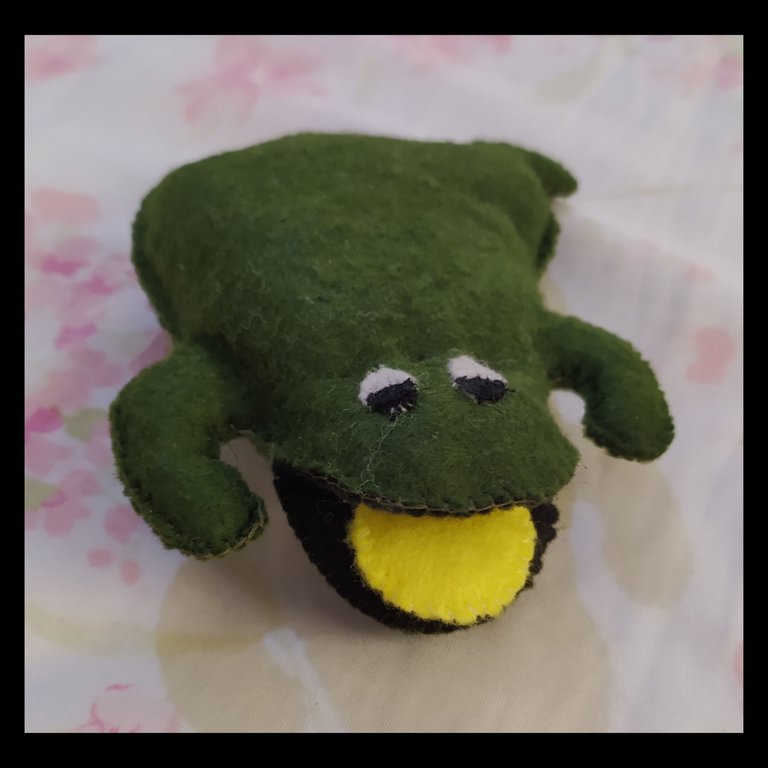
Este fue el resultado, espero les guste.
This was the result, I hope you like it.
Un abrazo inmenso para cada uno de los que se tomaron el tiempo de leer y apreciar mi post.
Si te gustó este contenido, puedes dejar un comentario, y visitar mi perfil @emybaby para encontrar más contenido de manualidades, recetas, challenges y más.
A big hug to everyone who took the time to read and appreciate my post.
If you liked this content, you can leave a comment, and visit my profile @emybaby to find more content on crafts, recipes, challenges and more.
Traducido con DeepL
Banner y ediciones con PicsArt y Cymera
Las fotos son de mi autoría
Translated with DeepL
Banner and editions with PicsArt y Cymera
The photos are of my authorship
The rewards earned on this comment will go directly to the person sharing the post on Twitter as long as they are registered with @poshtoken. Sign up at https://hiveposh.com.
#posh @ocd @ocdb @appreciator @ecency @curangel